This article on a walk in Chandni Chowk was recently published in a travel magazine for its June edition.
Armed with my pre-paid counterfoil, a policeman led me to an auto-rickshaw and instructed the driver to take me to Chandni Chowk. The driver silently signaled me to take the seat at the back, and started his rickety rickshaw. But once on the way, he spit out unprintable words cursing the policeman and his luck for having to go somewhere he did not wish to.

Chandni Chowk is a busy street – a complete contrast to open spaces, green lawns, leafy corners and quiet environs of the imposing landmark of Red Fort just next to it. The bustling market area of the street is full of people hurriedly moving from place to place, either buying and selling goods or offering services to people who come there to buy and sell.
Walking on the crowded avenue, I don’t see any clues to indicate the glorious yester years it is known for. In its heydays during the Mughal rule, Chandni Chowk was known for its spacious streets, palatial havelis and luxuries unseen in rest of Asia. Traders coming from corners of the continent like Kashgar and Kabul flocked the street, brining in goods to amuse the Mughal elite. A canal ran through the center of the main street carrying waters of River Yamuna, reflecting moonlight on bright nights, giving Chandni Chowk its name.
But today, what is seen in the place of the canal is a less appealing road-divider. A few havelis have survived unattended as crumbling evidences of the illustrious past. But the traders remain, albeit the local ones, selling less luxurious goods.
Buildings on either side of the street are packed with shops. They mostly sell clothes on the main street, but on exploring small claustrophobic lanes leading out of Chandni Chowk, called Katras, I find every conceivable goods under the sky. The shops still have a feel of ancient days and look like a far cry from the plush, brightly lit shopping areas of New Delhi. A McDonalds with its bright red backlit display stands apart from its neighbors, trying to be the first to bring an onslaught of change that is imminent. But rest of the street is long way from buckling to the wave of modernization.
I walk along the footpath, trying to make some space for myself in the middle of fast moving crowd. Every now and then I am intercepted by hopeful salesmen trying to get my attention and pull me into their shop.
“Do you want some women’s clothes?” some one asks me, “May be Salwar Kameez?”
I am not sure how successful he would be in selling women’s stuff to men; but he would know better.
A little ahead, another man is slightly more reasonable – “Would you like to buy shirts or trousers?” he asks.
But I am in no mood for shopping, nor do I need shirts or trousers. Its already dark and I have much of Chandni Chowk ahead of me, waiting to be explored. I increase my pace a little, trying to escape from frequently appearing salesmen. But whenever I look around casually and pause to see some wares, the shopkeepers jump at the opportunity.
“aao jee aao,” I hear them say – “come sir, come.” I have to ignore them and keep moving or a few truckloads of clothes will be pushed on me before I know.
But soon I get into a situation that requires me to go shopping. Stopping to get into Sis Ganj Gurudwara, I need something to cover my head. I always keep a hanky in my pocket, but at the right time when I need it, can’t find one. I walk into a nearby shop and ask the man at the desk for a hanky.
He nods at me, searches through a rack for a long time and comes back to me with a box. I am hoping to see a box full of handkerchiefs to pick from, but when he opens it, there is exactly one piece of bright white cloth lying folded at the bottom. I look up to him, hoping that he will show me more. But he is staring at me intently, almost telling me to pick the one he has shown. There is a brief pause; he wants me to act while I am hoping that he will. A few uneasy seconds pass before I break the silence –
“Do you have more?”
“This is the last piece left,” he responds expectantly, hoping that I pick it.
Lack of choice bothers me, and I try to step out, thanking him politely. But he is unhappy, and also seemed surprised that I am not buying ‘the one’. Unable to contain himself, he wants to know why am I not taking it. I am left with the job of finding an excuse to satisfy him. The salesperson at the next shop turned out much better: he pampers me with choices and I choose one in less than a minute.
Inside the Gurudwara, it is a sea change from the bustle of the market. Its spacious interiors, built from plush granite, shield from the outside noise. There are a good hundred people quietly meditating inside, and the prayers sung from the arena next to Guru Granth Sahib is soothing. I sit there along with the meditating pious lot for a few minutes, and reluctantly make my way out to explore more of Chandni Chowk.
The street is a miniature India in every essence: the chaos that define India are there to be seen in every corner. Haphazardly parked vehicles, loudspeakers installed on the street making a gurgling sound and emitting something incomprehensible, people everywhere, sleek modern cars and ancient ricketies going side by side on the streets. And within all this is some unseen order which ensure that everything some how keeps working smoothly. Even the religious diversity on the street is the essence of the whole country. At the beginning of the street is a large Jain Temple. A short walk takes me past a Church, followed by a Hindu temple and then a Gurudwara. At the far end of the road is a Mosque, all of them together screaming about the variety that the country is. It is easy to get carried away in this pandemonium of Chandni Chowk but never understand how the system manages to work and stay afloat. But the country survives this way, moving forward, keeping crises and achievements side by side.
Food is another thing to look forward to in Chandni Chowk. Parathewali Gali is a small easy-to-miss lane leading out of the main street, but is credited with some century old acclaimed establishments serving more than a dozen varieties of delicious Parathas.
‘Estd 1889,’ proclaims a sign proudly, and claims of ‘six generations of expertise’ in making Parathas. The fame of these shops is evident when I see pictures of visiting dignitaries in another shop, which lists a few former prime ministers. Another sign on a shop says their Parathas are made with ‘shudh desi ghee’. These deep fried Parathas are not for the calory conscious, and can leave you with excess supply of energy that takes days to burn. I am tempted to devour on them, but a heavy late lunch with a friend that afternoon has kept me full, leaving no space for more fatty stuffing.
Lines of food carts draw me towards Nai Sarak, a street next to Chandni Chowk. A cart loaded with pancake rolls stuffed with tomatoes, paneer and potatoes looks attractive; I ask the vendor for one. He picks one and heats it on a stove, cuts it into smaller pieces, tops it up with a brownish sweet sauce and then a greenish hot sauce over that before serving them in a bowl made of dried leaves.
I continue walking as I take a bite and am instantly carried to heaven. It tastes as good as it looks, with a sweet-and-sour feel melting instantly in my mouth and leaving me feeling good. I walk back to the vendor to convey my appreciation, whose face lights up and expands with a beaming smile when I say “bahut achha hai!”.
“This is called Paneer Chilla,” he explains, “its made of moong dal”.
Further ahead on Chandni Chowk, Billimoria is like an ocean of shoe shops. Shop after shop sells shoes, shoes and only shoes. It could well be the idea of shangri-la for women, but surprisingly I don’t see many members of the fairer sex.
I retrace my path after a quick visit to red sandstone structure of Fatehpuri Masjid at the other end of the street. To get back to my hotel, I now take the swank Delhi Metro from Chandni Chowk station instead of hailing an auto-rickshaw. So close to the ancient city full of crumbling structures, the sleek air conditioned station and fast moving trains are a symbol of emerging modern India and its future. It is visible everywhere – India is a country full of contrasts – where the old and new, good and bad, rich and poor exist together, side-by-side.
+ Also see: my travel photography workshop in Badami
+ A version of this article was published in the July issue of Harmony Magazine
Nearly 1,500 years ago, the mighty Chalukya Kings discovered a small gap among the rocky cliffs situated in the parched plains of today’s North Karnataka, covered by steep sandstone walls in three directions with a small opening to the north-west. They found it to be a secure place to govern their kingdom from, built a large tank in a depression surrounded by cliffs on three sides, carved a few temples in those rocks and established the center of a dynasty that ruled for nearly 600 years to control a large chunk of land between Narmada and Kaveri.
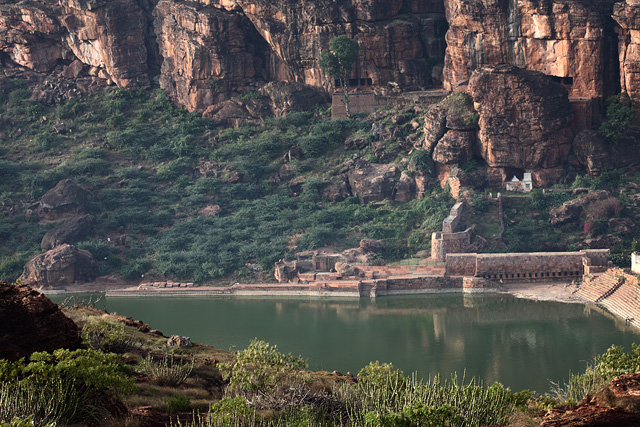
Cave temples and cliffs of Badami
This recorded history of Badami is interesting, but the mythology is even more fascinating. On his journey across the Vindhyas, Sage Agastya was invited by demons Vatapi and Ilvala for a meal. The brothers had the habit of calling guests home and kill them in the most innovative possible way. Vatapi would turn into a ram while Ilvala would cook its meat and offer to the guest. Once eaten, Vatapi would come out splitting the stomach of the guest, thus killing him. The story does not say why did they have to choose such circuitous route to achieve their mission, but it sure makes it very interesting.
But when it comes to legends, sages are always smarter than demons. Agastya knew the whole plan and digested Vatapi before he could come out, putting an end to the evils of the pair. Today, the cliffs around the Agastya Lake in Badami are believed to be the bodies of mighty demons who were defeated by the sage.
The legend would have brought some aura to the town, but it is the remains of history that attracted me here. Temples carved halfway up a cliff are the hallmark of Badami. Built by Chalukya Kings over a period of two centuries, they are among the best surviving structures of early Indian Architecture.
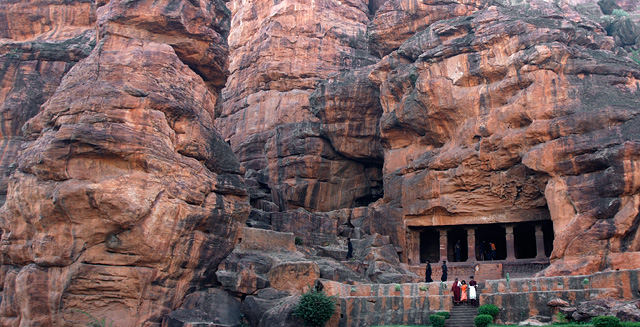
First of the four rock cut temples of Badami
There are four cave temples in Badami with three dedicated to Vedic Gods, the last one being a Jain Temple. The first three temples have some elaborate sandstone carvings of Hindu Pantheon such as Vamana stepping over Bali, dancing Nataraja, Varaha carrying Bhudevi and Vishnu seated on Vasuki. The Jain temple, smallest of the four has a series of Tirthankaras carved along the walls.
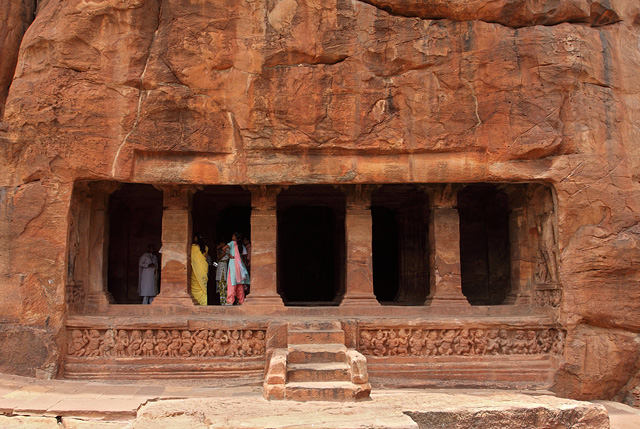
The rock cut temples
Chandru, my ASI certified guide at Badami, was knowledgeable and articulate. He stood in dance positions and held his hands in mudras when he described how the 18-handed statue of Nataraja can form 81 mudras in Bharatanatya by choosing any one of the left hands in combination with any of the right hands. We moved through caves as Chandru described the iconography and architecture, but my questions to him were mostly related to history.
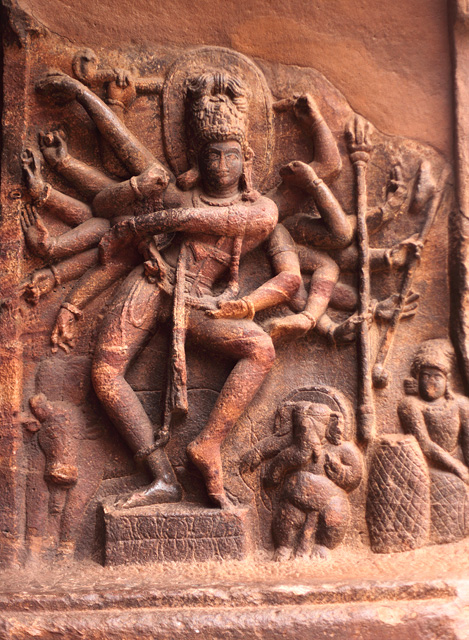
Nataraja relief in the first rock cut temple at Badami
The inscriptions in Badami and surrounding areas are a key to rediscovering most of the Chalukyan history. An inscription carved somewhere high up the rocks on the cliff opposite to the caves describes the times of the first Chalukyan Kings. Another inscription by Pallava King Narasimhavarman I informs of the brief occupation of Badami by Pallavas. A detailed inscription on a pillar at nearby Mahakoota Village, carved in the time of king Mangalesha, provides much needed information about the lineage of Chalukyas and the spread of their kingdom. An inscription in Aihole Village describe the victory of Pulikeshi II over Harshavardhana and another one gives vague clues about the existence and time period of renowned poet Kalidasa.
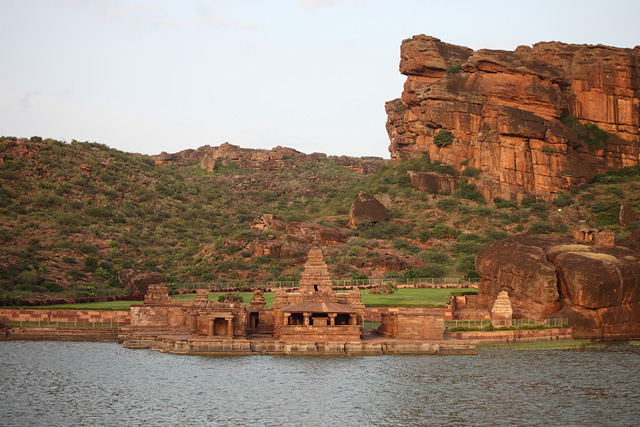
The grand setup of Bhoothanatha Temple, Badami
From my vantage point at these caves up in the hill, I could see the Bhoothanatha Temple at the edge of Agastya Lake. Unlike the cave temples that are full of visitors, the temple premises were empty, save for occasional drifting visitors. The Bhoothanatha Temple is in a grand setup, surrounded by walls of red sandstone rocks on three sides and the waters of the lake lapping up the steps in the front. Sitting in the temple courtyard that evening, I watched the cool breeze ruffling the lake surface as the evening sun disappear behind the town.
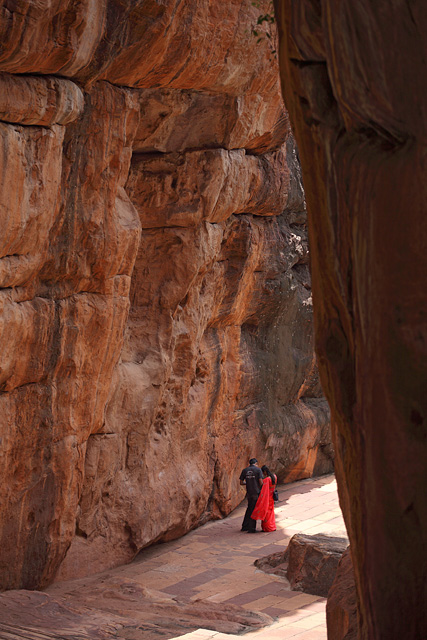
The narrow path through gaps in the sandstone walls of Badami
During my wanderings along the lake shore, I drifted towards the hills opposite to the caves and climbed a short flight of steps that took me up the table-land above. The steps climb through narrow gaps in the rocks that are wide enough at places just to let in a few people at a time. Sunlight peering through the gap and flaring up small sections of the wall make a colourful play of light and shade in these fissures. Up on the hill are a few temples, a few pillars and remains of a fort. Fortification of the hill must have been an easy task, as it mostly involved building walls to restrict entry through the cracks in the rock.
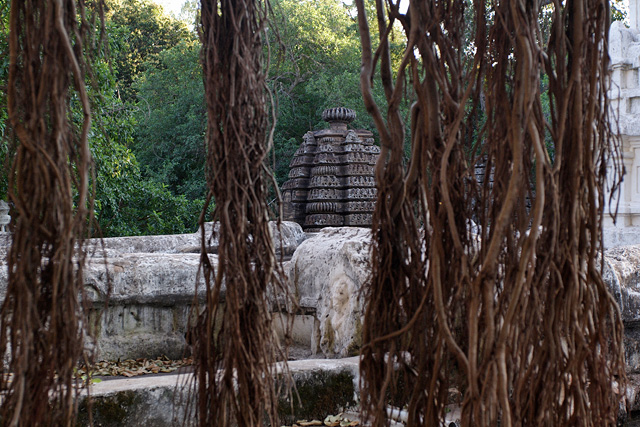
The leafy environs of Mahakuta near Badami
The area around Badami is rich in heritage and strewn with temples that belong to Chalukya era. Excursions from Badami took me first to Mahakoota, a small village dominated by a Chalukyan temple dedicated to Mahakuteshwara. Mahakoota appears like a green island in an ocean of parched land surrounding it. Next to the temple is a sacred grove with thick greenery that creates a cooler local climate that contrasts the scorching weather in the region. The courtyard of the temple is under the shade of large ficus trees. Roots hanging from the trees, temple towers hidden behind the leaves and the silence in the shade bring a calm and soothing feel to the temple surroundings.
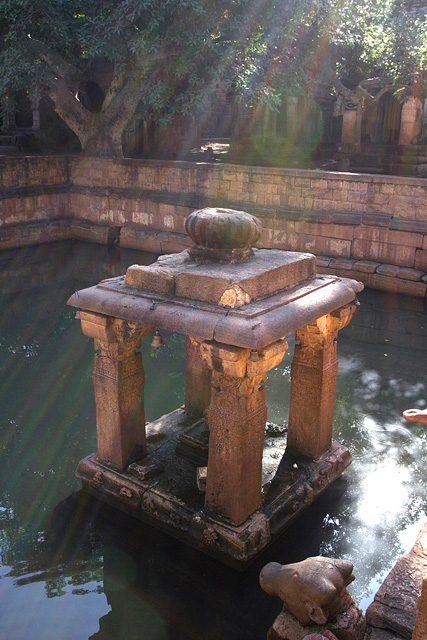
A mantapa at Mahakuta, near Badami
Not far from Mahakuta is Pattadakal, a UNESCO World Heritage Site. The temples here are made of beautiful red sandstone and the carvings have been fading over the years on the external walls due to effect of sunlight. But the interiors appear better preserved. The temples here are a mix of northern Nagar architecture and the Dravidian style of the south.
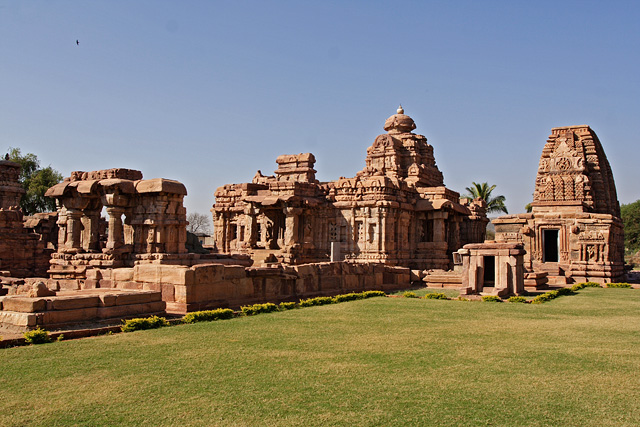
Pattadakal, a UNESCO World Heritage Site near Badami
Further ahead of Pattadakal is Aihole, a village littered with ancient structures that refuse to confirm to any specific style of temple building. With students of those days arriving here from every corner to learn and master the art of carving in stone, historians have often called Aihole as the ‘cradle of Indian architecture.’
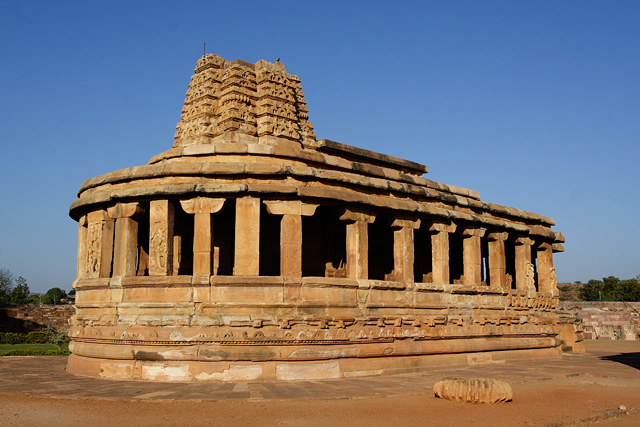
Durgi Gudi, at Aihole near Badami
The first thing that attracts the visitor in Aihole is the well maintained main enclosure of temples in the centre of the village. Taking a tour of the large Lad Khan Temple and well known Durgi Gudi that has parallels with parliament building in its façade, I heard my guide talk about a number of smaller temples spread around the village. Aided by his guidance, I went in search of these ancient structures that seemed to be visited by very few people.
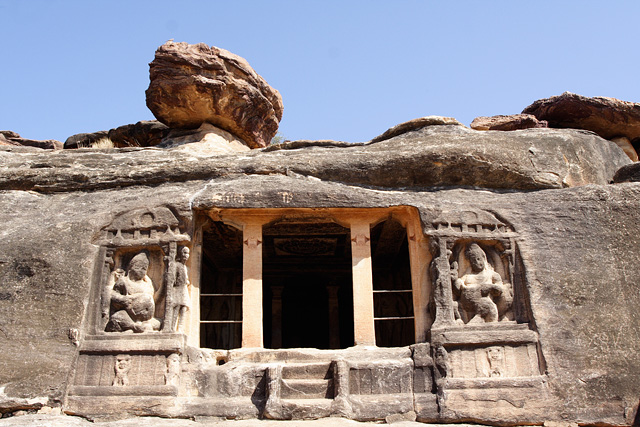
Ravanphadi, a rock cut temple at Aihole near Badami
Among the oldest of these temples is Ravan Phadi, dating back to later half of sixth century. It is a small rock-cut room with a linga in the centre and beautiful carvings on the inner side walls. To the west of Ravanphadi is Huchimalli Temple built in a more formal nagara style of architecture. The temple stands alone in an enclosure far away from other monuments, with its shrine visible from a distance. Seen from anywhere in Aihole is the Meguti Temple located at the top of a hill. Standing next to Meguti Temple, I can see the entire village dotted with ancient temples in all directions and River Malaprabha flowing at the edge of the hamlet.
My visits to Aihole, Badami and its neighbouring heavens of ancient architecture was fuelled by seeing beautiful images of Badami with foaming waters rushing down from its cliffs, as presented in tourist brochures. They were perhaps photographed during the peak monsoon months, but the time when I was there was marked with dry spells. All that I could see was the stains of algae at places where the waterfalls would come alive during the rains. However, the heritage sites in Badami and Pattadakal, the architectural experimentations of Aihole and the calm environs of Mahakoota more than made up for the missing waterfalls. But the appeal of waterfalls now gives me an excuse to plan another tour. As I write this, the monsoons have arrived in most parts of Karnataka and the met department is assuring of good rains for the next few months. It is perhaps time to plan another visit.
Here is a compilation of images of heritage sites in Hampi, made during my two visits to the place this year. In these visits, I attempted to go beyond merely documenting the temples, but tried looking for new angles and perspectives to capture them. I must admit that the time I spent at each monument is far less than I would have liked to, to be able to do justice to their beauty. I believe that good pictures are made by continuous and patient observation, taking time to immerse oneself in the surroundings. There will be many more visits to Hampi in the coming years, where I hope to spend time finding more perspectives and unseen beauty of these monuments.
Also see my images of birds of Hampi.
Virupaksha Templs’s tower is the tallest and among the most prominent structures in Hampi. While the deities in all other temples in Hampi were desecrated at some point in time, Virupaksha Temple remained intact. This is the only places among the old temple where the lord is still worshiped. Also read the debate on why Virupaksha Temple was not desecrated, on Anu’s blog.
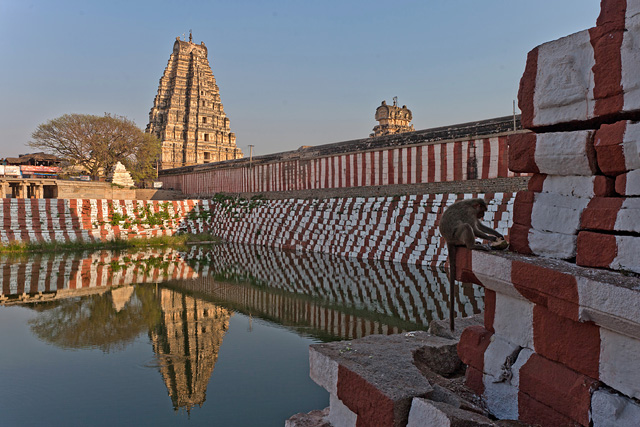
The insides of Virupaksha Temple.
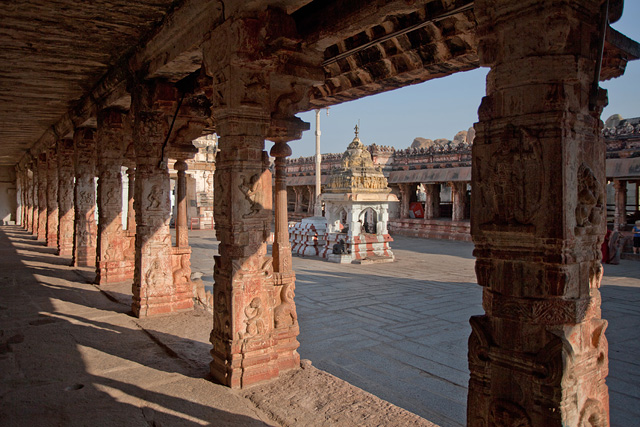
More views of Virupaksha Temple, taken from nearby Hemakuta Hill.
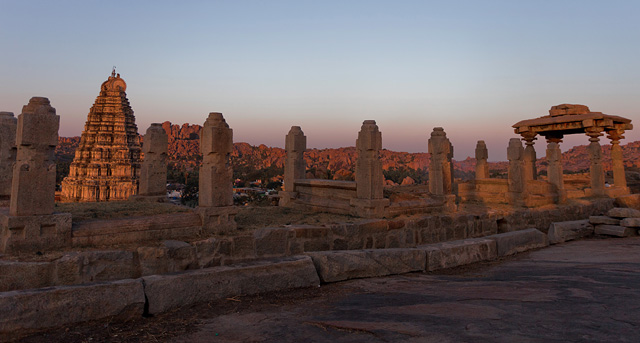
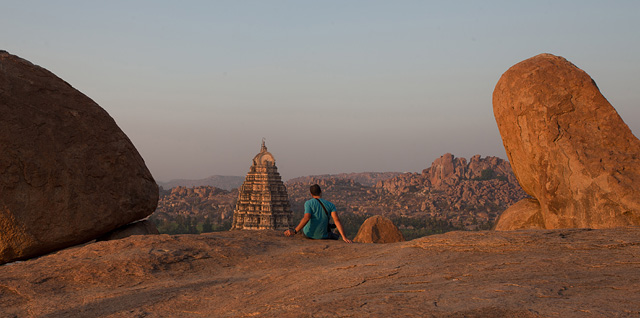
And here is how Hemakuta Hill looks from the courtyard of Virupaksha Temple. People arrive at the Hemakuta Hill in the evening hours to see the beautiful vistas of a boulder-strewn landscape and to watch the sunset. This picture was taken about thirty minutes before the hour of sunset.
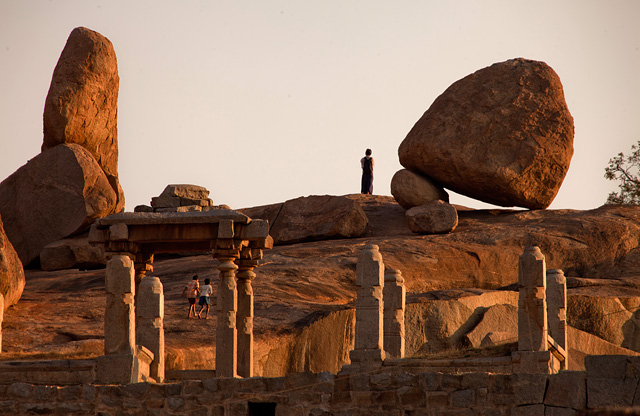
Here is a mendicant on one of the mantapas on Hemakuta Hill.
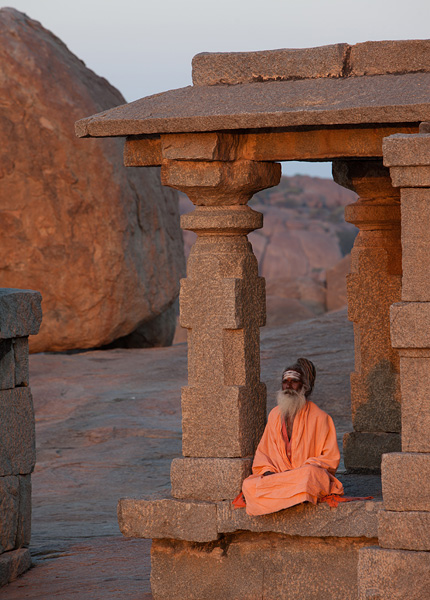
A long avenue, called Hampi Bazaar, located in front of Virupaksha Temple is said to be the place that symbolized the past riches of Hampi. This is where gold and diamonds were sold by the street side in the heydays of Vijayanagar Kingdom. Even today, a long shelter with hundreds of pillars has remained on both sides of the avenue, which once served as shops selling the riches. To the other end of the avenue is Matanga Parvata, said to be the highest point in Hampi. This mantapa is at the base of Matanga Parvata about a kilometer away from Virupaksha Temple at the other end of the avenue.
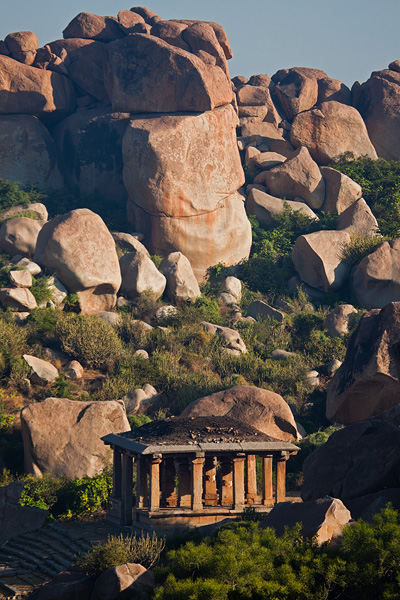
To the other side of Matanga Hill Achutaraya Temple, seen in the picture below.
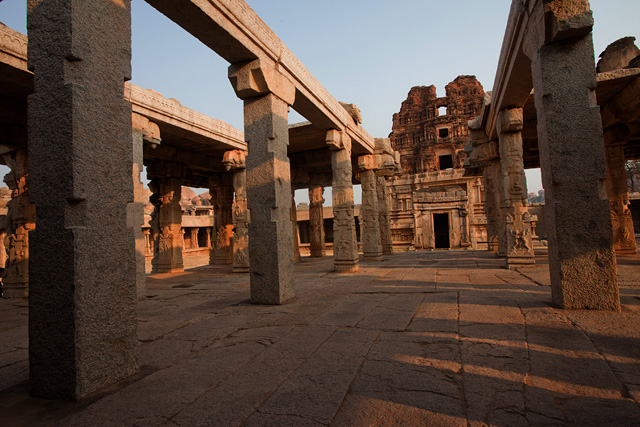
Similar to the bazaar in front of Virupaksha Temple, Achutaraya Temple also boasts of a wide and long avenue which once had shops lined on both sides. This Kalyani is at the other end of Achutaraya Bazaar.
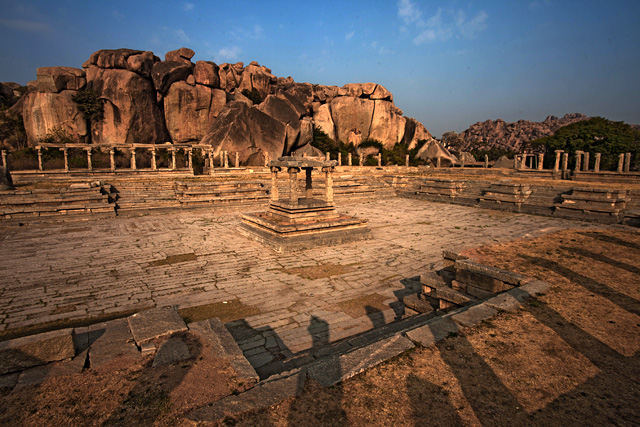
River Tungabhadra flows through Hampi, flowing close to Virupaksha Temple and the kalyani in front of Achutaraya Temple. Further, about a kilometer downstream on the bank of the river is Vijaya Vithala Temple, one of the major monuments of Hampi. It is most known for its musical pillars and a stone chariot in the temple courtyard. My personal favourite is this frangipani tree that adds a great charm to the temple premises. Thankfully, it was flowering during my last visit in February.
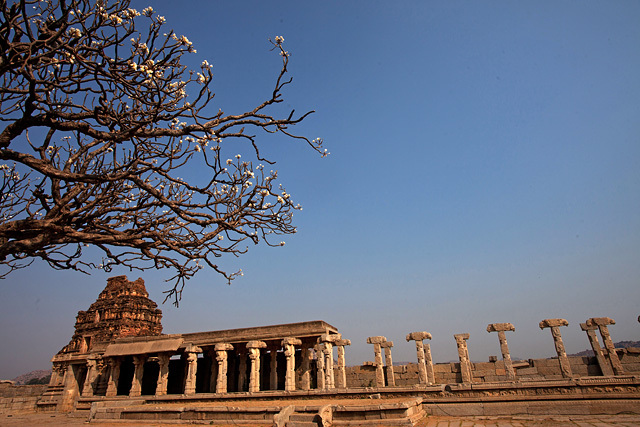
Lotus Mahal is another well-known monument in Hampi, located along with a series of sites that one can visit along with this. During my visit to the Mahal in January, we reached here just before sunset to catch the last golden rays of sun falling on the monument.
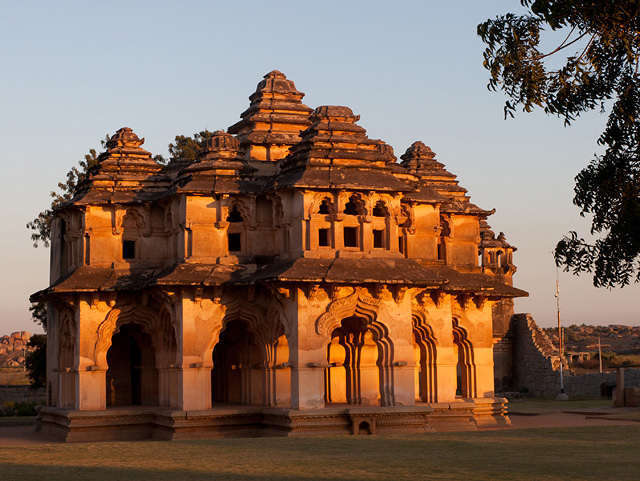
A closer look at Lotus Mahal.
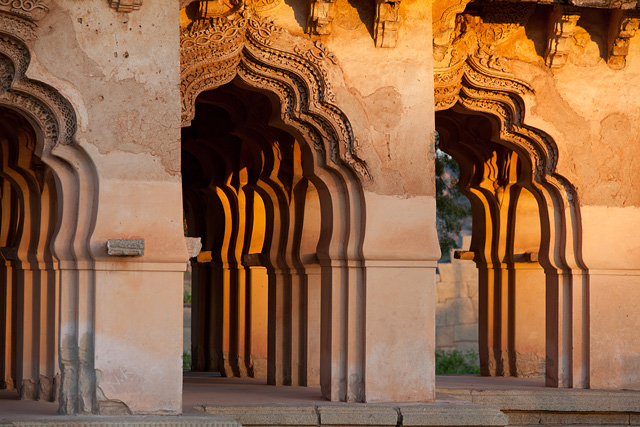
Near Lotus Mahal is a large enclosure where the royal family lived. The palace and other buildings in the enclosure do not exist any more. A large elevated platform from which the king addressed his subjects, and a series of tanks and aqueducts form the highlight of the royal enclosures. Here is a small section of a step well in the royal enclosure.
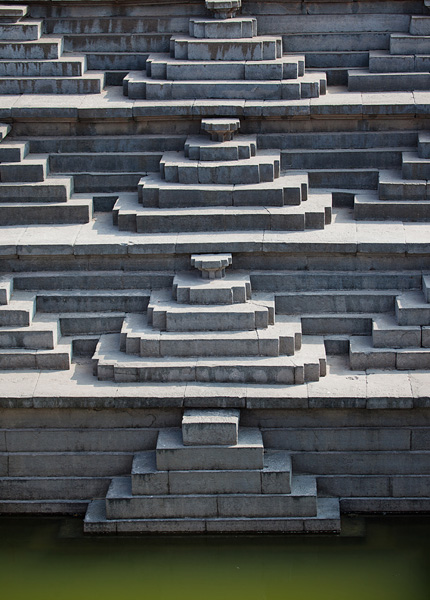
Not far from royal enclosure is the queen’s bath – a modest building with a tank in the center of it. Here is an image of the passage around the tank.
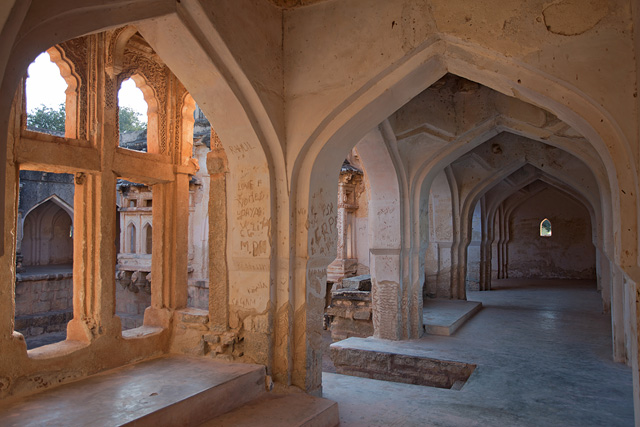
Prints of the image available. Request for prints

























